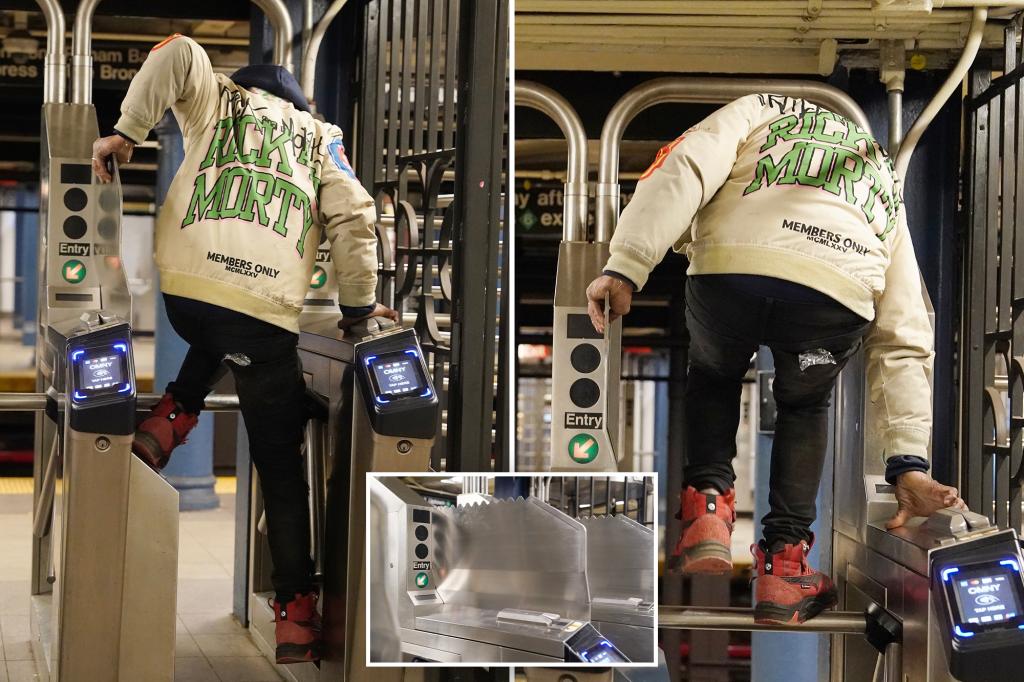Paragraph 1: The Elusive Subway Jumper
Barely a day after their installation, the new anti-fare evasion spikes at the 59th Street/Lexington Avenue subway station were rendered ineffective by a determined commuter. A photographer for The Post captured the moment the individual, clad in a "Rick and Morty" sweatshirt, effortlessly bypassed the newly implemented deterrent. Expressing his disregard for the spikes with a defiant expletive, the man leveraged the structure’s design flaws to vault over the turnstile, disappearing into the station unimpeded. This incident highlights the ongoing challenge faced by the Metropolitan Transportation Authority (MTA) in curbing fare evasion.
Paragraph 2: The MTA’s Latest Gambit and Public Reaction
The MTA’s latest attempt to combat fare evasion involves installing metal sheets with sharp edges atop and alongside the existing turnstile gates. The specific cost of this initiative remains undisclosed, as does the plan for its wider implementation across the subway system. Commuters frequenting the 59th Street/Lexington Avenue station, a hub for multiple subway lines, expressed skepticism about the effectiveness of the new measure. Veronica Pisani, a building manager from the Bronx, dismissed the spikes as a "silly and foolish" waste of money, predicting that determined fare evaders would easily find ways to circumvent them.
Paragraph 3: The Financial Burden of Fare Evasion
Fare evasion represents a significant financial drain on the MTA, costing the organization an estimated $500 million annually. This substantial loss of revenue has prompted the MTA to explore various strategies to recoup the funds, but these efforts have often been met with limited success. The recent incident involving the spiked turnstiles underscores the persistent challenge of effectively deterring fare evasion, even with the implementation of new physical barriers. The MTA’s struggle to address this issue highlights the complex interplay of infrastructure design, commuter behavior, and the financial pressures facing public transportation systems.
Paragraph 4: A History of Circumvented Measures
This is not the first time the MTA’s anti-fare evasion measures have been thwarted. In 2023, the MTA invested $700,000 in high-tech electronic gates designed to block fare evaders. However, the effectiveness of these gates was short-lived, as individuals quickly discovered and shared simple hacks on social media platforms like TikTok, demonstrating how to bypass the supposedly secure system. This episode, coupled with the recent incident involving the spiked turnstiles, paints a picture of an ongoing cat-and-mouse game between the MTA and fare evaders, highlighting the adaptability of those seeking to avoid paying fares and the challenges of developing truly effective deterrent measures.
Paragraph 5: Balancing Fare Hikes and System Improvements
In December 2023, the MTA approved a fare hike, raising the cost per swipe to $3, a 10-cent increase. This decision was made amidst significant investments in system improvements, including the purchase of 435 new subway cars at a cost of nearly $1.3 billion. MTA Chairman and CEO Janno Lieber defended the fare hike as a "good deal," emphasizing the need to balance the cost of system upgrades with the financial burden on riders. The fare increase is projected to take effect in the latter half of 2025, reflecting the MTA’s ongoing efforts to secure the necessary funding for maintaining and improving the subway system.
Paragraph 6: The Ongoing Challenge of Fare Evasion
The incident at the 59th Street/Lexington Avenue station serves as a microcosm of the larger issue of fare evasion plaguing the MTA. The ease with which the individual bypassed the newly installed spikes underscores the limitations of physical deterrents in addressing a complex problem rooted in both economic and social factors. The MTA’s ongoing efforts to curb fare evasion, from technological solutions to physical barriers, have consistently met with challenges, highlighting the need for a multifaceted approach that considers both the practicalities of enforcement and the underlying reasons behind fare evasion. The search for an effective and sustainable solution continues, as the MTA grapples with the financial implications of fare evasion while striving to maintain and improve the vital services it provides to millions of New Yorkers daily.

